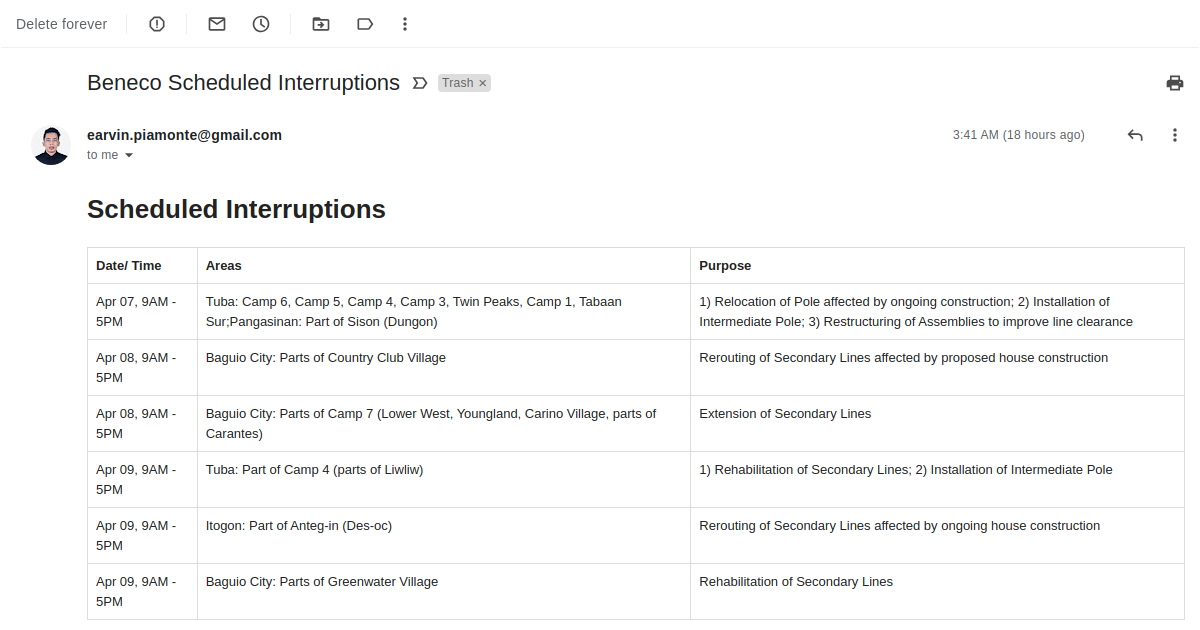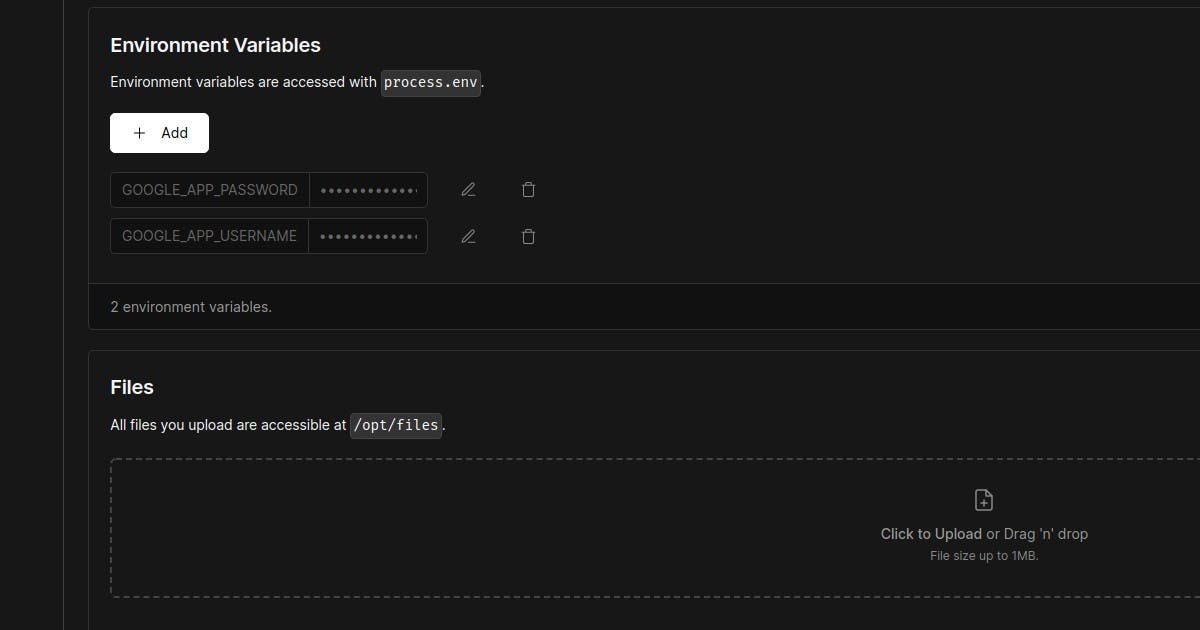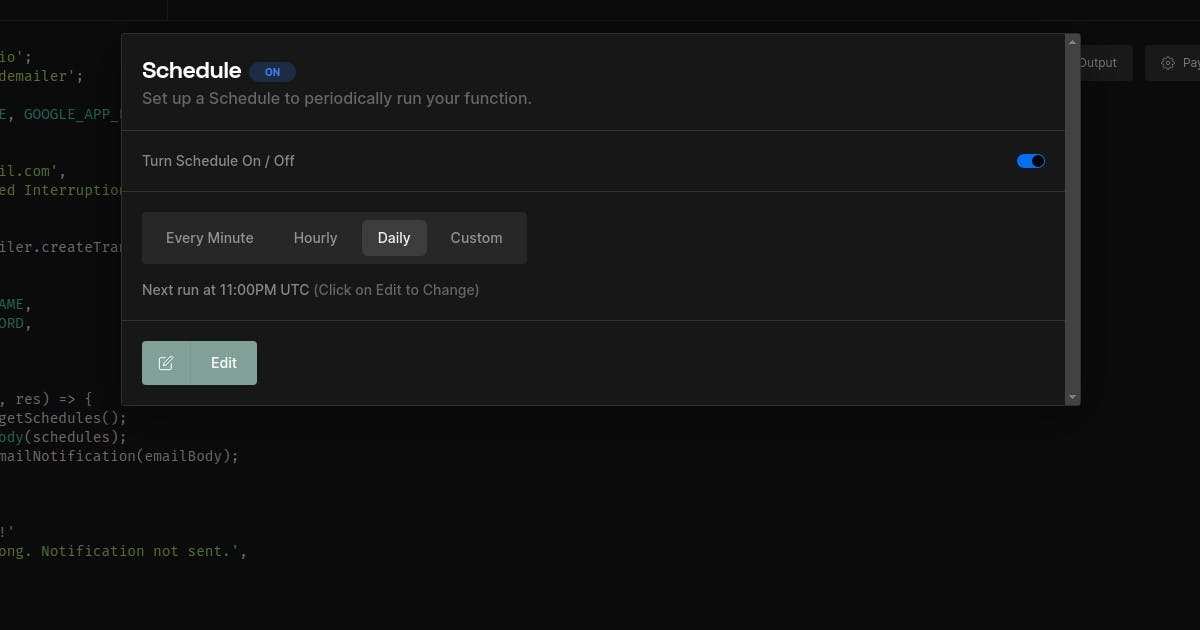post/
La Lune
April 8, 20226 min read

JavaScript, Node.js, Serverless
felt emo, made another serverless function.
So I was browsing random websites and for some unknown reason I revisited the website of an electric utility company in Baguio City, Beneco. And I noticed that the website had an update from the last time I visited it. It now features a "Scheduled Interruptions" table.
Now, this is helpful because consumers can easily check for the scheduled power interruptions and prepare ahead of time for the outage. At least for me since I don't have Facebook. Beneco regularly posts updates on their FB page. But I don't like visiting their page just to check for updates.
So it got me thinking to write some function that will scrape Beneco's website, specifically getting the data from the "Scheduled Interruptions" table and send the data over to my email, still in table format.
I quickly opened up a workspace at napkin.io and started coding.
Verse 1
The serverless function that I built have the following operations:
- fetch and parse the schedules from the website - beneco.com.ph
- construct an email template with the schedules in table format
- send the email to my address (scheduled)
Verse 2
The first function I wrote for the API endpoint was to fetch the schedules from the website.
const getSchedules = async () => {
const { data } = await axios.get('https://www.beneco.com.ph');
const { schedules } = parseSchedules(data);
return schedules;
};
Actually, before that, I first installed axios, cheerio and nodemailer on my workspace at Napkin.
To parse the data from the website, I used cheerio. Cheerio parses the HTML and provides an easy way to access the data in the HTML document.
Here's the function I came up, returning an array of schedule. The values that I need for each schedule are dateTime, areasAffected and purpose. jQuery flashbacks hehe.
const parseSchedules = (html) => {
const $ = cheerio.load(html);
const schedules = [];
$('.table__interruptions tbody tr').each((_, tr) => {
const $tr = $(tr);
const dateTime = $tr.find('td:eq(0)').html().replace('<br>', ', ');
const purpose = $tr.find('td:eq(1)').text();
const areasAffected = $tr.find('td:eq(2)').text();
const schedule = {
dateTime,
areasAffected,
purpose,
};
schedules.push(schedule);
});
return { schedules };
};
Chorus
The next thing I did was to construct the email template and made a function that will send the email over to my address.
I decided to place the parts of the markup on separate functions so that I can easily update, add styles and use it anywhere.
Here's the body of the email template.
const EmailBody = (schedules) => {
return `
<h1>Scheduled Interruptions</h1>
<div style="margin-bottom: 30px;">
${Table(schedules)}
</div>
`;
};
I used nodemailer for sending the email notification.
const sendEmailNotification = async (emailBody) => {
const mailOptions = {
...MAIL_OPTIONS,
html: emailBody,
};
const { accepted } = await transporter.sendMail(mailOptions);
return accepted;
};
Bridge
Now, the main function of the API endpoint:
const handler = async (req, res) => {
const schedules = await getSchedules();
const emailBody = EmailBody(schedules);
const sent = await sendEmailNotification(emailBody);
const response = {
message: sent
? 'Notification sent!'
: 'Something went wrong. Notification not sent.',
};
res.json(response);
};
I usually name serverless functions handler and later on at the bottom I can just do export default handler;.
I used Gmail as the service for sending email with Nodemailer. I also added two environment variables: GOOGLE_USERNAME and GOOGLE_PASSWORD on my workspace at Napkin.

On the code, I then access those variables at process.env with destructuring assignment.
const { GOOGLE_APP_USERNAME, GOOGLE_APP_PASSWORD } = process.env;
Outro
Here's the whole code of the serverless function I wrote for this simple project.
import axios from 'axios';
import cheerio from 'cheerio';
import nodemailer from 'nodemailer';
const { GOOGLE_APP_USERNAME, GOOGLE_APP_PASSWORD } = process.env;
const MAIL_OPTIONS = {
to: 'earvin.piamonte@gmail.com',
subject: 'Beneco Scheduled Interruptions',
};
const transporter = nodemailer.createTransport({
service: 'gmail',
auth: {
user: GOOGLE_APP_USERNAME,
pass: GOOGLE_APP_PASSWORD,
},
});
const handler = async (req, res) => {
const schedules = await getSchedules();
const emailBody = EmailBody(schedules);
const sent = await sendEmailNotification(emailBody);
const response = {
message: sent
? 'Notification sent!'
: 'Something went wrong. Notification not sent.',
};
res.json(response);
};
const getSchedules = async () => {
const { data } = await axios.get('https://www.beneco.com.ph');
const { schedules } = parseSchedules(data);
return schedules;
};
const parseSchedules = (html) => {
const $ = cheerio.load(html);
const schedules = [];
$('.table__interruptions tbody tr').each((_, tr) => {
const $tr = $(tr);
const dateTime = $tr.find('td:eq(0)').html().replace('<br>', ', ');
const purpose = $tr.find('td:eq(1)').text();
const areasAffected = $tr.find('td:eq(2)').text();
const schedule = {
dateTime,
areasAffected,
purpose,
};
schedules.push(schedule);
});
return { schedules };
};
const sendEmailNotification = async (emailBody) => {
const mailOptions = {
...MAIL_OPTIONS,
html: emailBody,
};
const { accepted } = await transporter.sendMail(mailOptions);
return accepted;
};
const EmailBody = (schedules) => {
return `
<h1>Scheduled Interruptions</h1>
<div style="margin-bottom: 30px;">
${Table(schedules)}
</div>
`;
};
const Table = (schedules) => {
const styles = ['border-collapse: collapse', 'overflow: scroll'];
return `
<table style="${inlineStyles(styles)}">
${TableHead()}
<tbody>
${TableRows(schedules)}
</tbody>
</table>
`;
};
const TableHead = () => {
const styles = [
'font-weight: bold',
'text-align: left',
'border: 1px solid #ddd',
'padding: 8px',
];
return `
<thead>
<tr>
<th style="${inlineStyles(styles)} width: 10%">Date/ Time</th>
<th style="${inlineStyles(styles)} width: 45%">Areas</th>
<th style="${inlineStyles(styles)} width: 45%">Purpose</th>
</tr>
</thead>
`;
};
const TableRows = (schedules) => {
return schedules
.map((schedule) => {
const cellValues = Object.values(schedule);
return `
<tr>
${cellValues.map((value) => TableCell(value)).join('')}
<tr>
`;
})
.join('');
};
const TableCell = (value) => {
const styles = [
'vertical-align: top',
'border: 1px solid #ddd',
'padding: 8px',
];
return `
<td style="${inlineStyles(styles)}">${value}</td>
`;
};
const inlineStyles = (styles) =>
styles.length > 0 ? `${styles.join('; ')};` : '';
export default handler;
License: MIT License · Copyright (c) 2022 Noel Earvin Piamonte
There are standard ways in making email templates so that it could display nicely on most of the email clients but I'm happy with the markup I wrote for now.
Lastly, I turned on the "Schedule" on the workspace so that this function will be triggered on a specific period.

With this function, I am now receiving email notifications that contain the scheduled power interruptions. Well, at least for now. If Beneco improves the security of their website or at least just made a breaking change, this function won't work.
Thanks for reading.
So we stay awake like we always do. And we try to recreate.